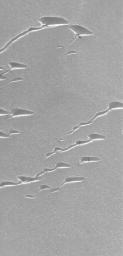
|
Frosty Dunes
- Click the image above for a larger view
- Full-Res JPEG (836 x 1734) (264.6 kB)
- Full-Res TIFF (836 x 1734) (1.5 MB)
Caption:
12 April 2006
Today, the MOC Team celebrates the 45th anniversary of the first human flight into space, that of Yuri Gagarin on 12 April 1961, and the 25th anniversary of the first NASA Space Shuttle flight on 12 April 1981, by briefly pondering the wonders of our Solar System and the opportunities of the age in which we live. Although humans have not ventured to the Moon in more than 30 years, and have not yet gone to Mars, we can all go there through the eyes of our robotic explorers.
Mars, perhaps the most Earth-like (yet so very different!) planet in our star's system, is tilted on its axis by about 25°-not all that different than Earth's ~23.5°. Thus, Mars, like Earth, experiences a changing of seasons as the planet revolves around the Sun. At high latitudes in each hemisphere during autumn and winter, carbon dioxide frost accumulates on the surface.
This Mars Global Surveyor (MGS) Mars Orbiter Camera (MOC) image shows dunes covered and delineated by seasonal frost in the north polar region of Mars. The winds responsible for the formation of these dunes blew primarily from the northwest (upper left), with additional influences from the north and northeast. During the late spring and summer seasons, these dunes would look much darker than their surroundings, but in this late winter image, the dunes and the plains on which they occur are all covered with carbon dioxide frost.
Location near
: 78.4°N, 76.7°W
Image width
: ~3 km (~1.9 mi)
Illumination from
: lower left
Season
: Northern Winter
Cataloging Keywords:
| Name | Value | Additional Values |
|---|---|---|
| Target | Mars | |
| System | ||
| Target Type | Planet | |
| Mission | Mars Global Surveyor (MGS) | |
| Instrument Host | Mars Global Surveyor | |
| Host Type | Orbiter | |
| Instrument | Mars Orbiter Camera (MOC) | |
| Detector | ||
| Extra Keywords | Dune, Grayscale, Moon | |
| Acquisition Date | ||
| Release Date | 2006-04-12 | |
| Date in Caption | 1961-04-12 | 1981-04-12, 2006-04-12 |
| Image Credit | NASA/JPL/Malin Space Science Systems | |
| Source | photojournal.jpl.nasa.gov/catalog/PIA08069 | |
| Identifier | PIA08069 | |
